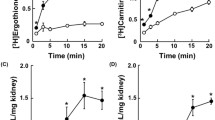Abstract
In order to study the specificities of the contraluminal anion transport systems, the inhibitory potency of substituted benzene analogs on influx of [3H]PAH, [14C]succinate, and [35S]sulfate from the interstitium into cortical tubular cells has been determined in situ: (1) Contraluminal [3H]PAH influx is moderately inhibited by benzene-carboxylate and benzene-sulfonate, and strongly by benzene-dicarboxylates,-disulfonates and carboxy-benzene-sulfonates, if the substituents are located at positions 1 and 3 or 1 and 4. The affinity of the PAH transporter to polysubstituted benzoates increases with increasing hydrophobicity, decreasing electron density at the carboxyl group and decreasing pKa. Similar dependencies are observed for phenols. Benzaldehydes which do not carry an ionic negative charge are accepted by the PAH-transporter, if they possess a second partially charged aldehyde or NO2-group. (2) Contraluminal [14C]succinate influx is inhibited by benzene 1,3- or 1,4-dicarboxylates,-disulfonates and 1,3-or 1,4-carboxybenzene-sulfonates. Monosubstituted benzoates do not interact with the dicarboxylate transporter, but NO2-polysubstituted benzoates do. Phenol itself and 2-substituted phenol interact weakly possibly due to oligomer formation. (3) The contraluminal sulfate transporter interacts only with compounds which show a negative group accumulation such as 3,5-dinitro- or 3,5-dichloro-substituted salicylates. The data are consistent with three separate anion transport systems in the contraluminal membrane: The PAH transporter interacts with hydrophobic molecules carrying one or two negative charges (−COO−, −SO −3 ) or two or more than two partial negative charges (−OH, −CHO, −SO2NH2, −NO2). The dicarboxylate transporter requires two electronegative ionic charges (−COO−, −SO −3 ) at 5–9 Å distance or one ionic and several partial charges (−Cl, −NO2) at a favourable distance. The sulfate transporter interacts with molecules which have neighbouring electronegative charge accumulation.
Similar content being viewed by others
References
Bevington PR (1969) Data reduction and error analysis for the physical sciences. McGraw-Hill, New York, p 312
Dean JA (1973) Lange's handbook of chemistry, 11th edn., McGraw-Hill, New York, pp 5.15–5.40
Fritzsch G, Haase W, Rumrich G, Fasold H, Ullrich KJ (1984) A stopped flow capillary perfusion method to evaluate contraluminal transport parameters of methylsuccinate from interstitium into renal proximal tubular cells. Pflügers Arch 400:250–256
Fritzsch G, Rumrich G, Ullrich KJ (1988) Anion transport through the contraluminal cell membrane of renal proximal tubule: influence of acidity, molecular charge distribution, hydrophobic domains and steric properties on the inhibitory activity of organic anions. Biochim Biophys Acta
Guggino SE, Martin GJ, Aronson PS (1983) Specificity and modes of the anion exchanger in dog renal microvillus membranes. Am J Physiol 244:F612-F621
Hansch C, Leo A, Unger SH, Kim KH, Nikaitani D, Lien EJ (1973) Aromatic substituent constants for structure-activity correlations. J Med Chem 16:1207–1216
Lücke H, Stange G, Murer H (1979) Sulphate-ion/sodium-ion co-transport by brush-border membrane vesicles isolated from rat kidney cortex. Biochem J 182:223–229
Morrison RT, Boyd RN (1974) Lehrbuch der organischen Chemie. Verlag Chemie, Weinheim, p 855 and 899
Nikolski BP (1959) Dissoziationskonstanten von Säuren und Basen in wäßrigen Lösungen. Handbuch des Chemikers, vol 3. VEB Verlag Technik, Berlin, pp 425–430
Oesch U, Brzozka Z, Xu A, Rusterholz B, Suter G, Pham HV, Welti DH, Ammann D, Pretsch E, Simon W (1986) Design of neutral hydrogen ion carriers for solvent polymeric membrane electrodes of selected pH range. Anal Chem 58:2285–2289
Robinson RA, Stokes RH (1959) Electrolyte solutions. Butterworth, London, pp 527–537.10
Russel FGM (1988) Renal clearance of anionic drugs. Mechanism of interactions of organic anion transport in dog kidney. Proefschrift, Katholieke Universiteit Nijmegen, Nijmegen
Shimada H, Moewes B, Burckhardt G (1987) Indirect coupling to Na+ of p-aminohippuric acid uptake into rat renal basolateral membrane vesicles. Am J Physiol 253:F795-F801
Ullrich KJ (1986) Polarity of the proximal tubular cell: Comparison of luminal and contraluminal transport systems for hexoses, dicarboxylates, and sulfate. In: Krück F, Thurau K (eds) Endocrine regulation of electrolyte balance. Springer, Berlin Heidelberg New York, pp 28–35
Ullrich KJ, Rumrich G (1988) Contraluminal transport systems in the proximal renal tubule involved in secretion of organic anions. Am J Physiol 254:F453–462
Ullrich KJ, Rumrich G (1988) Biotransformation and renal transport of xenobiotics and prevention of nephrotoxicity. The Bulletin, Mount Desert Island Biological Laboratory, 27 (suppl) 36–40
Ullrich KJ, Fasold H, Rumrich G, Klöss S (1984) Secretion and contraluminal uptake of dicarboxylic acids in the proximal convolution of rat kidney. Pflügers Arch 400:241–249
Ullrich KJ, Rumrich G, Klöss S (1984) Contraluminal sulfate transport in the proximal tubule of the rat kidney. I. Kinetics, effect of K+, Na+, Ca2+, H+ and anions. Pflügers Arch 402: 264–271
Ullrich KJ, Rumrich G, Klöss S (1985) Contraluminal sulfate transport in the proximal tubule of the rat kidney. III. Specificity: Disulfonates, di- and tri-carboxylates and sulfocarboxylates. Pflügers Arch 404:300–306
Ullrich KJ, Rumrich G, Klöss S, Lang H-J (1985) Contraluminal sulfate transport in the proximal tubule of the rat kidney. V. Specificity: Phenolphthaleins, sulfonphthaleins, and other sulfo dyes, sulfamoyl-compounds and diphenylamine-2-carboxylates. Pflügers Arch 404:311–318
Ullrich KJ, Rumrich G, Fritzsch G, Klöss S (1987) Contraluminal para-aminohippurate (PAH) transport in the proximal tubule of the rat kidney. I. Kinetics, influence of cations, anions and capillary preperfusion. Pflügers Arch 409:229–235
Ullrich KJ, Rumrich G, Fritzsch G, Klöss S (1987) Contraluminal paraaminohippurate (PAH) transport in the proximal tubule of the rat kidney. II. Specificity: Aliphatic dicarboxylic acids. Pflügers Arch 408:38–45
Ullrich KJ, Rumrich G, Klöss S (1987) Contraluminal paraaminohippurate transport in the proximal tubule of the rat kidney. III. Specificity: Monocarboxylic acids. Pflügers Arch 409:547–554
Weast RC, Selby SM (1966) Handbook of chemistry and physics, 47th edn. The Chemical Rubber Co., Cleveland, pp D86-D87
Wright SH, Kippen I, Klinenberg JR, Wright EM (1980) Specificity of the transport system for tricarboxylic acid cycle intermediates in renal brush borders. J Membr Biol 57:73–82
Author information
Authors and Affiliations
Rights and permissions
About this article
Cite this article
Ullrich, K.J., Rumrich, G. & Klöss, S. Contraluminal para-aminohippurate (PAH) transport in the proximal tubule of the rat kidney. Pflugers Arch. 413, 134–146 (1988). https://doi.org/10.1007/BF00582523
Received:
Accepted:
Issue Date:
DOI: https://doi.org/10.1007/BF00582523




